In October 2001, Apple introduced the original 5 GB iPod with FireWire as its only data and charging port. Steve Jobs previewed the original iPhone in January 2007 – ten years ago and just over five years after iPod introduction. The iPhone shipped at the end of June 2007, and released the first iPod touch – a slightly stripped down iPhone with no phone or mobile data capabilities – in September 2007.
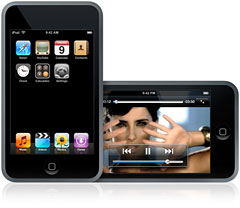 Ever since then, the iPod touch (sometimes called the iTouch) has been the iPhone’s weaker sibling with less features. The brilliant thing for Apple was leveraging all the work done to create the iPhone, so almost all of the R&D work had already been done.
Ever since then, the iPod touch (sometimes called the iTouch) has been the iPhone’s weaker sibling with less features. The brilliant thing for Apple was leveraging all the work done to create the iPhone, so almost all of the R&D work had already been done.
2007: The First Generation
The 8 GB iPhone originally retailed at $599 and was not available with any discount. It was an AT&T exclusive at first, and you had to have a 2-year AT&T contact to buy one from the mobile carrier. In September 2007, in response to complaints from early iPhone buyers when the 8 GB iPhone was reduced in price to $399, Apple offered $200 in store credit to anyone who had paid the higher price. Apple discontinued the $499 4 GB iPhone at the same time.
The iPod touch had been introduced just days before this at $299 with 8 GB of storage. It had the same screen resolution, the same processor and speed, the same amount of memory, and the same OS as the iPhone – but at half the price.
That price created an instant marked for the iPod touch. You didn’t need to sign a 2-year mobile contract to buy it, and it had most of the apps supplied with the iPhone. Even at $100 less than the 8 GB iPhone after the price drop, it offered a lot of value.
The iPod touch was also available with 16 GB of storage, something the iPhone didn’t get until February 2008. And later in February, Apple added a 32 GB iPod touch, again giving it a higher capacity than the iPhone offered.
2008: The Second Generation
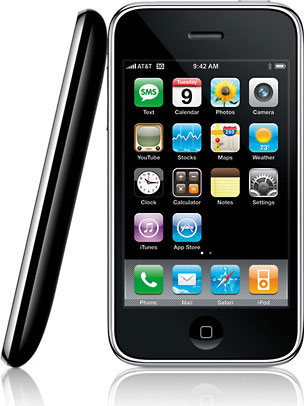 The biggest drawback of the original iPhone was that it only supported EDGE mobile data networking, not 3G. The iPhone 3G fixed that when it was introduced in July 2008. It also gained GPS and was the first device to ship with iPhone OS 2.0 – the first version with the App Store.
The biggest drawback of the original iPhone was that it only supported EDGE mobile data networking, not 3G. The iPhone 3G fixed that when it was introduced in July 2008. It also gained GPS and was the first device to ship with iPhone OS 2.0 – the first version with the App Store.
The second generation iPod touch arrived in September 2008 with the same 8, 16, and 32 GB configurations as the original. Prices were better, with the 8 GB model retailing for $229, 16 GB for $299, and 32 GB for $399. Like the iPhone 3G, it supported the App Store.
Besides having a higher capacity option, the iPod touch had one more advantage over the iPhone 3G: It ran its CPU at 532 MHz vs. 412 MHz in the original iPhone, original iPod touch, and iPhone 3G. That’s nearly 30% more processing power for the less costly device.
2009: The Third Generation
In June 2009, Apple gave us the iPhone 3GS, a faster version of the iPhone 3G running its CPU at 600 MHz. That was close to a 50% boost in performance when you factor in that the 3GS had twice the system memory of the 3G. In fact, Apple claimed the 3GS was up to twice as fast as the 3G. It originally shipped in 16 GB and 32 GB versions, with an 8 GB model introduced as the entry-level iPhone when the iPhone 4 arrived in June 2010.
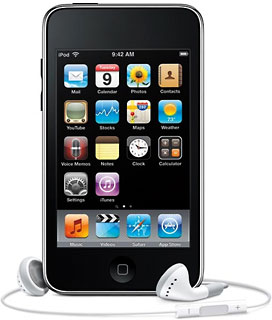 The 3G iPod touch, introduced in September 2009, also had twice the system memory of its predecessors and ran at the same 600 MHz speed as the iPhone 3GS. The 3G iPod touch was available with 32 GB of storage for $299, and with 64 GB for $399.
The 3G iPod touch, introduced in September 2009, also had twice the system memory of its predecessors and ran at the same 600 MHz speed as the iPhone 3GS. The 3G iPod touch was available with 32 GB of storage for $299, and with 64 GB for $399.
2010: The Fourth Generation
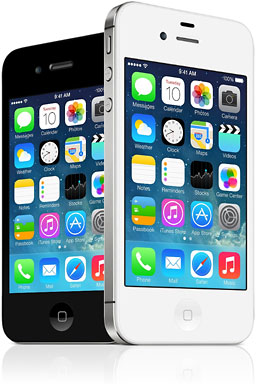 The iPhone 4 gave us a whole new iPhone form factor, added the front-facing FaceTime camera, and introduced the incredible (for its day) Retina Display with 326 pixels per inch. The new screen was enough to hook most users. Once you saw it, you wanted it.
The iPhone 4 gave us a whole new iPhone form factor, added the front-facing FaceTime camera, and introduced the incredible (for its day) Retina Display with 326 pixels per inch. The new screen was enough to hook most users. Once you saw it, you wanted it.
Apple once again boosted the iPhone’s power, this time running its new Apple-designed A4 CPU at 800 MHz and once again doubling system memory. Like the 3GS, it was available in 16 GB and 32 GB configurations, with an 8 GB model introduced when the iPhone 4 became the entry-level iPhone.
The iPhone 4 was the first one available for CDMA networks, which meant that Verizon could sell it in the USA starting in January 2011. The iPhone 4 was available in a white version starting in April 2011.
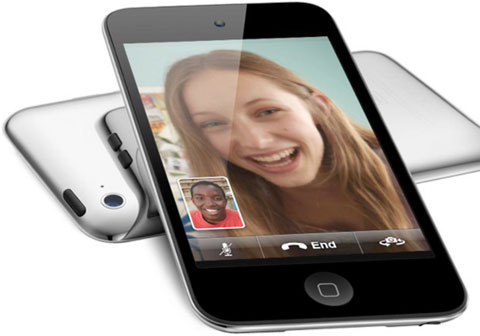 Like clockwork, the 4G iPod touch arrived in September 2010. It was the first iPod touch with a camera, albeit lower resolution than the iPhone 4 offered, and also the first iPod touch with a FaceTime camera. The 4G iPod touch was initially available in 8 GB, 32 GB, and 64 GB configurations, with a 16 GB model added in September 2012.
Like clockwork, the 4G iPod touch arrived in September 2010. It was the first iPod touch with a camera, albeit lower resolution than the iPhone 4 offered, and also the first iPod touch with a FaceTime camera. The 4G iPod touch was initially available in 8 GB, 32 GB, and 64 GB configurations, with a 16 GB model added in September 2012.
Best of all, the 4G iPod touch had the same Retina Display resolution as the iPhone 4. Between the new screen and built-in cameras, this was the iPod touch for FaceTime.
Up to this point, the iPod touch had matched or beat the processing power of the equivalent iPhone and also offered higher capacity versions than were available to iPhone buyers.
2011: New iPhone, No New iPod touch
With the iPhone 4S, Apple introduced its first “world phone” – GSM and CDMA support were built into the same device instead of Apple building two separate versions. (There was a separate version specifically designed for the China market.) The iPhone 4S used Apple’s new dual-core A5 processor at the same 800 MHz, which made it remarkably perky compared to earlier iPhones, and its 8 MP camera made it the first iPhone capable of recording 1080p video.
The iPhone 4S sold for $649 with 16 GB of storage, $749 with 32 GB, and $849 with 64 GB – the first iPhone with such a high capacity, equaling the highest capacity iPod touch for the first time. An 8 GB iPhone 4S arrived in September 2012 as Apple’s entry-level model.
There was no new iPod touch in 2011.
2012: iPhone 5 and 5G iPod touch
It is kind of odd that Apple introduced the iPhone 5 in September. Previous models had all been June or July roll-outs. The big news with the iPhone 5 was a slightly larger form factor than the 4 and 4S but with a significantly larger screen optimized for 16:9 video. The dual-core Apple A6 chip runs at a blistering 1.3 GHz, and subjectively it feels two generations more powerful than the iPhone 4S, in part helped by 1 GB of system memory.
The big new feature was Apple’s Lightning connector, which was much smaller than the old 30-pin dock connector and was reversible, so you couldn’t plug it in the wrong way.
Standard configurations were 16 GB, 32 GB, and 64 GB of storage at $199, $299, and $399 respectively with a 2-year service plan – or $649, $749, and $849 without a contract.
The 5G iPod touch, introduced the same month, also moved to an 1136 x 640 pixel display with the same storage options as the iPhone 5. Unfortunately, the 5G iPod touch didn’t get the A6 processor. Instead, it was built around the same 800 MHz A4 chip as the iPhone 4S.
Geekbench 2 gives the 5G iPod touch a score of 616, while the iPhone 5 scores 1654 – 170% more power! This was the biggest performance differential between the current iPod touch and iPhone to date.
On the plus side, the 5G iPod touch sold for $299 with 32 GB and $399 with 64 GB. A 16 GB version was added at $199 in June 2014.
The 5G iPod touch remained the top-end iPod touch from September 2012 until the 6G iPod touch arrived in July 2015 – nearly three years.
2013: The iPhone Goes 64-bit, No New iPod touch
By moving to the 64-bit 1.3 GHz Apple A7 processor, the September 2013 iPhone 5S ran about 50% faster then the iPhone 5 based on Geekbench scores, but subjectively it feels twice as fast. It was also the first iPhone available in gold.
The new user technology was Touch ID, which puts a fingerprint sensor on the home button.
There was no new iPod touch in 2013.
2014: Bigger iPhones, Still No New iPod touch
The Android world was all about screen size, and the 4″ screen on the iPhone 5 family, while an improvement over the 3.5″ display on earlier iPhones, just wasn’t enough to attract potential switchers to Apple.
Instead of one model, Apple introduced two in 2014: The iPhone 6 has a large 4.7″ 1334 x 750 pixel display, while the iPhone 6 Plus has a stunningly huge 5.5″ 1920 x 1080 screen – the same resolution as most high definition TV sets over 36″ in size and also a popular resolution on Android phones. The 6 Plus has roughly 60% as many pixels as the iPad mini.
The Apple A8 processor was not a big improvement over the A7, but it ran a bit faster at 1.4 GHz.
There was no new iPod touch in 2014.
2015: iPhone 6S, 6G iPod touch
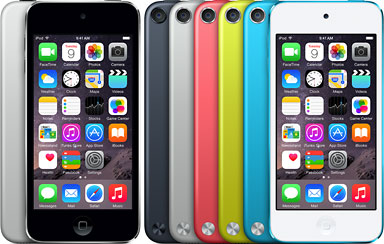 Nearly three years after Apple had introduced the 5G iPod touch, it finally delivered its successor in July 2015. In an odd twist, the 6G iPod touch uses the same A8 processor as the iPhone 6 but the same 4″ 1136 x 640 pixel screen size and resolution as the iPhone 5 family. Apple also underclocked its 1.4 GHz processor to run at 1.1 GHz.
Nearly three years after Apple had introduced the 5G iPod touch, it finally delivered its successor in July 2015. In an odd twist, the 6G iPod touch uses the same A8 processor as the iPhone 6 but the same 4″ 1136 x 640 pixel screen size and resolution as the iPhone 5 family. Apple also underclocked its 1.4 GHz processor to run at 1.1 GHz.
Even with its scaled back CPU speed, this made the 6G iPod touch a lot more powerful than the 5G model it replaced.
Two months later, Apple rolled out the iPhone 6S and 6S Plus, which run Apple’s A9 chip at 1.85 GHz, have 2 GB of system memory, and use a faster memory bus, making them quite a bit more powerful than the 2014 models they replaced. The hot new features were a 12 MP camera, a new type of photograph called Live Photos, and 3D Touch. The 6S and 6S Plus were the first iPhones capable of shooting 4K video.
2016: iPhone SE, iPhone 7 and 7 Plus, No New iPod touch
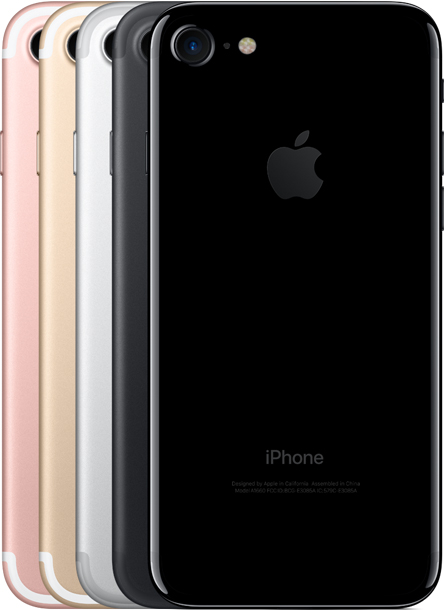 Seeing an ongoing demand for its 4″ iPhones, Apple introduced the iPhone SE in March 2016. Feature for feature, spec for spec, it is almost identical to the iPhone 6S except for screen size.
Seeing an ongoing demand for its 4″ iPhones, Apple introduced the iPhone SE in March 2016. Feature for feature, spec for spec, it is almost identical to the iPhone 6S except for screen size.
The iPhone 7 is more famous for what it doesn’t have than anything else. It is the first Apple mobile device without the traditional 3.5mm headphone jack. Apple includes Lightning headphones with the iPhone 7 and 7 Plus, as well as a Lightning-to-3.5mm adapter for traditional headphones, speakers, etc. But what Apple really wants to sell you is its $159 AirPods, which Apple can’t build fast enough to keep up with demand.
The iPhone 7 family uses a new A10 processor with four cores – two high speed cores, and two low speed cores for when the iPhone is in standby mode. They also have two cameras, one with regular coverage and a 2x telephoto lens for increased magnification.
Why Buy an iPod touch?
Looking at what mobile carriers are offering on trade-ins, its no surprise that the iPod touch market is small. If customers can get $150 in credit for trading in their two-generation-old 64 GB iPhone 6 Plus toward an iPhone 7 or 7 Plus, who is going to spend $199 for a 16 GB 6G iPod touch or $299 for the 64 GB version?
Ever since I got my iPhone 4S, I’ve been using my old iPhone 3GS as an iPod touch equivalent by putting it in Airplane Mode and then enabling WiFi and, sometimes, Bluetooth. And ever since I got my iPhone 5, I’ve done the same with my iPhone 4S. It makes more sense to dedicate an old iPhone to music or Facebook or some other use than make your new iPhone do everything. You can easily set things up so both your new iPhone and your old one have the same apps and settings if that’s what you want.
If Apple wants to milk the iPod touch for all it’s worth, it should offer it in three sizes – the current 4.0″ plus the same 4.7″ and 5.5″ as the iPhone 6-7. As for me, I’m really enjoying playing with an iPhone 6 Plus in Airplane Mode around the house. It has a fantastic screen, but it’s bigger than I would want to carry around as my regular phone.
Keywords: #iphone #ipodtouch
Short link: https://goo.gl/ryXezf
searchword: ipodtouch

